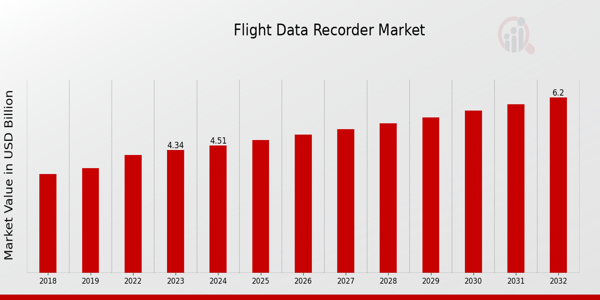Flight Data Recorder (FDR) Market Outlook
Flight Data Recorder (FDR), a silent witness to every flight, capturing a tapestry of technical data that paints a vivid picture of the journey. As the Flight Data Recorder Market expands, projected to reach USD 6.2 billion by 2032 with a steady 4.05% CAGR, it's essential to understand the human story woven into these numbers.
Behind the technical specifications and growth projections lies a fundamental commitment to safety. The FDR's purpose transcends mere data collection; it's about understanding, learning, and ultimately, preventing future incidents. Each recorded parameter—altitude, airspeed, engine performance, control inputs—represents a moment in a complex ballet of human and machine interaction. When things go awry, the FDR provides a crucial, objective account, enabling investigators to piece together the sequence of events and identify potential causes.
This growth isn't simply about bigger numbers; it reflects an evolution in aviation safety. The increasing demand for advanced FDRs signifies a deeper understanding of the value of comprehensive data. Modern recorders boast higher storage capacities, more sensitive sensors, and improved data analysis capabilities. This translates to richer, more detailed insights, allowing for a more nuanced understanding of flight dynamics and potential risks.
Imagine the investigators, painstakingly analysing the data, searching for subtle anomalies, patterns, and clues. They're not just looking at numbers; they're trying to understand the human decisions and technical challenges faced by the flight crew. The FDR becomes a tool for empathy, allowing investigators to walk in the pilots' shoes and reconstruct the critical moments leading up to an event.
Furthermore, the growth in the Flight Data Recorder Market Size is driven by increasing regulatory requirements and a heightened focus on proactive safety measures. Airlines and regulatory bodies are recognizing the importance of continuous monitoring and data analysis to identify potential safety risks before they escalate. This shift towards a proactive approach is transforming aviation safety, moving beyond reactive investigations to preventative measures.
The data captured by FDRs is not confined to accident investigations. It also plays a vital role in training and operational improvements. Flight crews can review data from their own flights, identifying areas for improvement and refining their skills. Airlines can analyze fleet-wide data to identify trends and patterns, optimize operational procedures, and enhance safety protocols.
The human element extends to the engineers and technicians who develop, manufacture, and maintain these critical devices. Their dedication to precision and reliability ensures that the FDR performs flawlessly when needed most. This commitment to quality is paramount, as the integrity of the data is essential for accurate investigations and informed decision-making.
The projected growth of the FDR market also reflects the increasing complexity of modern aircraft. As aircraft become more sophisticated, with advanced avionics and complex systems, the need for comprehensive data recording becomes even more critical. The FDR acts as a safeguard, providing a detailed record of the aircraft's performance and behavior in a wide range of operating conditions.
However, the human story also brings to light the ethical considerations surrounding data privacy. As FDRs become more sophisticated and collect more data, it's crucial to ensure that this information is used responsibly and ethically. Balancing the need for safety with the protection of individual privacy is a delicate task that requires careful consideration and robust safeguards.
In essence, the growth of the Flight Data Recorder Market size is a testament to the aviation industry's unwavering commitment to safety. It's a story of human ingenuity, dedication, and a relentless pursuit of knowledge. The black box, once a symbol of mystery and tragedy, is now a beacon of hope, a tool for understanding, and a catalyst for continuous improvement.
The projected CAGR of 4.05% and the market size reaching USD 6.2 billion by 2032 are not just statistics; they represent a collective effort to make air travel safer for everyone. They symbolize the countless hours of research, development, and analysis that go into ensuring that every flight is as safe as possible. Ultimately, the story of the Flight Data Recorder Market is a human story, a story of learning, growth, and a shared commitment to safeguarding the skies.
